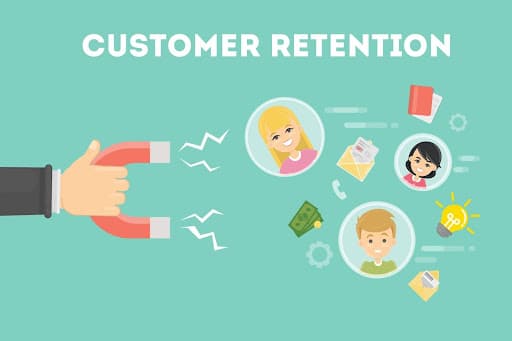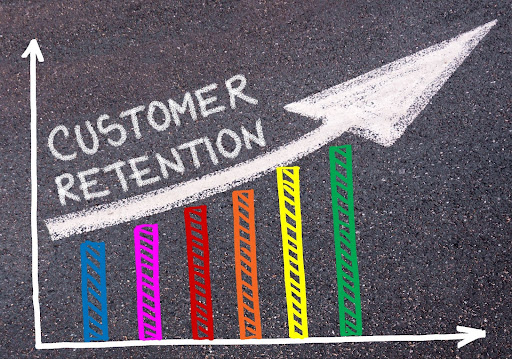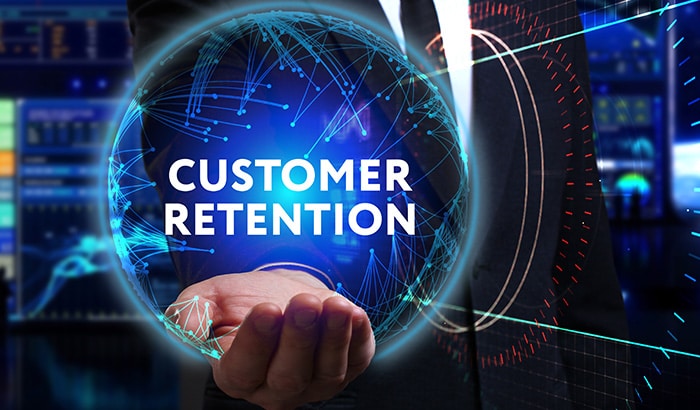Customer retention and loyalty form the bedrock of a thriving business. They may be considered buzzwords, but they really are the keys to lasting success. While acquiring new customers is undoubtedly important, nurturing existing ones is equally — if not more — critical.
By the end of this blog, you’ll possess a treasure trove of innovative tactics and ideas to bolster your customer relationships and ensure long-term prosperity. So, let’s dive into the fascinating world of customer loyalty and retention strategies and discover how they can transform your business.
Personalized customer experiences
In the realm of customer retention, personalization is the secret sauce that transforms casual buyers into loyal enthusiasts. The essence of this approach lies in recognizing and embracing the uniqueness of each customer.
Every customer is distinct. There’s no one-size-fits-all approach. Begin by immersing yourself in data. This is the goldmine of insights into your customers’ behavior, purchase history, and preferences. Gather this treasure trove of information through surveys, online interactions, and patterns of purchase.
This data-driven journey unveils the motivation behind each customer, what they value most, and the challenges they face. Some may prioritize affordability, while others seek top-tier quality or exceptional service. This knowledge forms the foundation for crafting personalized experiences that deeply resonate with your audience.
Tailoring products, services, and communication
Once you’ve gained a profound understanding of your customers, the next step is customization that goes beyond surface-level personalization. It’s a holistic approach to delivering tailored experiences.
Customized products
Offer options for personalization when it fits. If you’re in fashion, provide embroidery or monogramming choices for clothing. In software, create features that users can customize to meet their unique needs.
Personalized service
Train your customer service team to address customers by name, recall previous interactions, and proactively cater to their needs. A personal touch in service can significantly elevate the customer experience.
Targeted communication
Craft marketing messages that are intimately tied to customer preferences and behaviors. Leverage your data to send relevant product suggestions, promotions, and content. For instance, if a customer frequently buys fitness gear, keep them informed about the latest arrivals in that category.

Elevating customer support for lasting loyalty
Exceptional customer support is the linchpin of success when it comes to customer loyalty and retention. Crafting experiences that customers remember and cherish is the pivotal role of outstanding customer support.
Exceptional customer support is the heartbeat of customer retention for several compelling reasons:
- Swift issue resolution: Customer support means addressing concerns promptly and effectively. When customers encounter challenges and receive rapid resolutions, they’re more likely to stick around.
- Building trust: A responsive and dependable support team builds trust. Knowing that any issues will be handled professionally reassures customers and solidifies their loyalty.
- Emotional connection: When customers feel valued and supported during their interactions, they form a deeper connection with your brand.
- Word-of-mouth promotion: Satisfied customers often become enthusiastic advocates. They eagerly share their positive support experiences with others, potentially bringing in new patrons.
- Reduced churn: Providing top-tier support reduces customer churn rates. When customers trust that your support team can assist them effectively, they have fewer reasons to explore alternatives.
Innovative approaches to enhance customer support experiences
Elevating customer support experiences entails a blend of cutting-edge technology, comprehensive training, and genuine empathy. Here are some innovative strategies to consider:
Round-the-clock availability
In today’s interconnected world, customers expect support around the clock. Consider implementing AI-driven chatbots or outsourcing support to ensure uninterrupted assistance.
Self-service resources
Provide an array of self-service options, including comprehensive knowledge bases, FAQs, and video tutorials. Empower customers to find solutions independently, at their convenience.
Personalized interactions
Train your support team to engage with customers on a personal level. Addressing customers by their names, referencing previous interactions, and demonstrating empathy leave a profound impact.
Proactive engagement
Implement proactive support by reaching out to customers before they encounter problems. For instance, if you notice a customer repeatedly facing the same issue, offer a preemptive solution.
Loyalty programs reimagined: unleashing customer engagement
In the past, loyalty programs mainly centered around offering discounts, points, or freebies after a set number of transactions. While these have proven effective, they often lack the element of surprise and become predictable. Innovative loyalty programs, on the other hand, break the mold by introducing fresh, engaging, and personalized ways to reward customers.
Creative loyalty program ideas
Experiential rewards
Rather than the typical discounts, provide customers with exclusive experiences. Think VIP access to events, behind-the-scenes tours, or hands-on workshops related to your products or services. These unique encounters leave a lasting impression.
Gamified engagement
Gamification adds an element of fun and challenge. Develop games or challenges that encourage customers to interact with your brand. Reward them for completing tasks, achieving milestones, or referring friends, making loyalty a playful journey.
Subscription-based loyalty
Consider loyalty subscription models where customers pay a monthly fee in exchange for premium benefits. This approach fosters long-term commitment and recurring revenue, ensuring ongoing engagement.
Community building
Nurture a loyal community by connecting customers who share common interests or passions related to your brand. Facilitate discussions, organize meetups, and recognize active community members to create a sense of belonging.
Surprises and delights
The unexpected can create memorable moments. Surprise your customers with personalized gifts, handwritten thank-you notes, or unexpected rewards to express genuine appreciation.
Philanthropic initiatives
Incorporate charitable elements into your loyalty program. For each purchase or interaction, allocate a percentage to a cause aligned with your customers’ values. It’s a meaningful way to engage while giving back.
Tiered reward structures
Implement tiered loyalty levels based on customer engagement. As customers progress, offer increasingly exclusive rewards and benefits to incentivize continuous participation and advancement.
Engagement points
Go beyond transactional rewards by awarding points for various forms of engagement, including social media shares, referrals, and reviews. Encourage customers to interact with your brand on multiple fronts.
Collaborations and partnerships
Forge collaborations with complementary businesses or brands. Joint loyalty programs introduce customers to related products or services, enhancing engagement through diversity.
Nurturing loyalty through user-generated content and community building
There are two more remarkable strategies that have the potential to strengthen customer loyalty over the long haul: harnessing the immense power of User-Generated Content (UGC) and fostering a vibrant community centered around your brand.
Leveraging the impact of user-generated content
User-generated content refers to any content, whether it’s in the form of text, images, videos, or reviews, created by your customers or users themselves rather than by your brand. It represents the authentic expression of their experiences with your products or services.
UGC inherently carries a high level of credibility and authenticity because it originates from real customers who have experienced your products or services. When potential buyers see others genuinely enjoying what your brand offers, it instills confidence and trust.
Encouraging customers to share their experiences fosters a sense of involvement and invites them to actively engage with your brand. It creates and nurtures a two-way relationship. Positive UGC serves as compelling social proof, influencing the decisions of prospective customers in your favor.
What’s more, UGC diversifies your content arsenal, allowing you to leverage various formats such as customer stories, testimonials, product demonstration videos, and more in your marketing efforts. UGC is a cost-effective alternative to crafting your content from scratch, providing a valuable resource you can repurpose across various marketing channels.
Strategies to encourage user-generated content
Engage in contests and challenges
Run contests or challenges that motivate customers to creatively share their experiences. Offer enticing prizes or recognition for the most outstanding submissions.
Promote unique hashtags
Create and promote unique hashtags for customers to use when sharing content related to your brand. This not only aids in content discovery but also facilitates easy sharing.
Encourage customer reviews
Actively encourage customers to leave reviews on your website or third-party review platforms. Amplify positive reviews by sharing them across your social media channels.
Showcase user stories
Dedicate sections on your website or social media platforms to feature customer stories. Highlight their unique journeys, challenges they’ve overcome, and how your brand played a pivotal role.
Fostering a community around your brand for long-term loyalty
Building a brand community holds paramount importance in your customer retention strategy. It fosters a profound sense of belonging among your customers. In a thriving community, customers no longer perceive themselves as mere consumers; instead, they become integral members of a larger, shared experience.
Within this shared space, customers discover common interests and passions related to your brand, leading to deeper connections and heightened loyalty. Moreover, a brand community facilitates peer-to-peer support, offering customers a platform to seek advice, share valuable insights, and extend assistance to their peers.
This collaborative environment proves to be invaluable for troubleshooting issues and enhancing the overall customer experience. It’s an indispensable element of any successful retention strategy.
Strategies for building a brand community
Establish a dedicated space
Create a dedicated online platform, whether it’s a forum, a social media group, or a specialized section on your website, where community members interact and connect.
Initiate and moderate discussions
Take the lead in initiating and moderating discussions that revolve around topics related to your industry, products, or services. Encourage active participation and diverse perspectives.
Offer exclusive content and events
Incentivize community membership by providing exclusive content, promotions, or events tailored to their interests. Make them feel valued and appreciated for their loyalty.
Recognize and reward
Acknowledge and reward active community members for their contributions. Publicly appreciate their dedication and loyalty to your brand, fostering a sense of pride and belonging.
Listen and adapt
Pay close attention to the feedback and insights shared within your community. Use these invaluable inputs to enhance your offerings and elevate the overall customer experience.
Elevating loyalty with gamification and interactive experiences
There are two specific and innovative approaches that have the power to transform the way you nurture customer loyalty: gamification and interactive experiences.
The thrill of gamification
Gamification transforms everyday interactions with your brand into experiences filled with the thrill of achievement. It’s one of the best ways to infuse your customer journey with elements that make it engaging, exciting, and rewarding.
Gamification seamlessly integrates the universal desires for goal achievement, outperforming peers, and earning recognition into loyalty strategies, resulting in a wellspring of engagement.
Central to the magic of gamification is its emphasis on progress tracking, rewards, and challenges. Customers embark on a journey where they chart their advancement, unlock enticing rewards, and ascend through loyalty tiers. This fosters a profound sense of accomplishment that keeps them returning for more.
Gamified experiences often include elements of competition or collaboration that allow customers to compete with peers, share their victories on social media, or collaborate to achieve common objectives. All of this ultimately strengthens their bond with the brand.
Beyond the entertainment factor, gamification generates valuable data — customer behavior, preferences, and engagement patterns — that businesses can harness to refine loyalty programs and personalize offerings. Brands that embrace gamification offer fun and engaging experiences while also conveying their commitment to delivering extraordinary, memorable interactions to solidify brand loyalty.
Interactive experiences: a journey of participation
Interactive experiences redefine customer engagement by transforming them from passive observers into active participants. Placing customers at the core of your engagement strategy empowers them to make choices, provide feedback, and shape their own journey. This sense of empowerment fosters customer-centric engagement.
Interactivity yields valuable customer preference data, allowing for the creation of personalized recommendations, content, and rewards. By imparting useful information through interactive content, such as quizzes or product configurators, brands position themselves as knowledgeable and helpful resources, adding value to the customer experience.
Another aspect of interactive experiences is considering how they evoke emotions, whether through fun challenges, touching storytelling, or responsive customer support. By inviting customers to share their thoughts and opinions, brands create a constructive feedback loop, demonstrating dedication to enhancing the customer experience and reinforcing the connection between the brand and its customers.

Sustainability and corporate social responsibility
Two powerful pillars that will enhance your brand’s reputation and create lasting bonds with your audience are sustainability and Corporate Social Responsibility (CSR).
These are more than trendy terms; sustainability and corporate social responsibility represent a commitment to ethical practices that resonate deeply with today’s consumers. These principles have a ripple effect on loyalty and demonstrate your brand’s dedication to making a positive impact on the world.
In a time when consumers actively seek brands that align with their values, championing sustainability creates an immediate connection with like-minded customers who share those values.
Sustainability practices are built on transparency, and sharing your ethical journey with customers fosters trust and confidence. Customers appreciate the honesty and integrity behind your actions. Sustainable and socially responsible products empower customers to make choices that align with their values, further strengthening their loyalty.
Additionally, sustainability stories and initiatives often evoke emotions, whether they involve supporting a cause or championing environmental preservation. These emotional connections result in enduring brand loyalty, as customers feel a deep connection to your brand’s purpose and mission.
Strategies for seamlessly embracing sustainability and CSR
Define your purpose
Start by defining your brand’s purpose and values. Which causes align with your mission? Aligning your purpose with sustainability ensures authenticity.
Eco-friendly operations
Implement eco-friendly practices in your operations, from sustainable sourcing to waste reduction. Your commitment to responsible business operations becomes a cornerstone of your brand.
Transparent communication
Communicate your sustainability journey openly. Share your progress, challenges, and success stories with your audience. Transparency builds trust.
Partnerships and collaborations
Collaborate with like-minded organizations and NGOs to amplify your impact. Joint initiatives can create a ripple effect, drawing more customers to your brand’s ethos.
Educate and involve
Educate your customers about the importance of sustainability and CSR. Encourage their participation in your initiatives, turning them into active advocates for your cause.
Data-driven retention strategies: the science behind customer loyalty
Customer data is the compass guiding businesses toward building lasting relationships. Let’s delve into the transformative power of data-driven strategies for customer retention.
Understanding your customers begins with collecting and analyzing their data. This goes beyond basic demographics; it involves creating rich customer profiles that encompass behavior, preferences, and history. By doing so, you gain profound insights into who your customers are.
Segmentation takes your data one step further by dividing your customer base into groups with shared characteristics. These segments might be based on factors like purchase history, engagement level, or preferences. Segmentation empowers you to tailor your retention efforts to specific customer needs.
Tracking and analyzing customer behavior is a cornerstone of data-driven retention. How do customers interact with your brand? What products or services do they engage with the most? Behavior analysis offers invaluable clues for keeping customers engaged.
Listening to customer feedback is paramount. It’s a two-way street where customers share their thoughts and concerns. A proactive approach to addressing feedback is essential for building trust and loyalty.
Predictive analytics and personalization
Predictive analytics utilizes historical data and machine learning to forecast future customer behavior. This empowers businesses to take preemptive action to retain customers before issues arise.
Using customer data, you are able to deliver personalized product recommendations, content, and communications. This level of customization deepens customer engagement.
Predictive churn modeling identifies customers at risk of leaving. Armed with this insight, you can intervene with tailored retention strategies, offering incentives or solutions to retain them.
Automation for efficiency
Automation tools help streamline data analysis and action. Automated retention strategies respond swiftly to customer behaviors, which ensures timely and relevant interactions.
Lifecycle marketing
Align your marketing efforts with the customer lifecycle. Tailor your strategies to different stages, from onboarding new customers to nurturing long-term loyalty.
Harnessing the wealth of customer data available will allow you to craft retention strategies while fostering genuine connections.

Omnichannel engagement: creating seamless connections with your customers
In the world of modern customer engagement, omnichannel strategy is a pivotal approach. Now, let’s take a closer look at the significance of omnichannel engagement and how it plays a vital role in retaining your valuable customers.
Meeting your customers where they are
Today, customers interact with brands through a variety of channels, including social media, emails, physical stores, and websites. The essence of omnichannel engagement lies in connecting with your customers wherever they choose to engage with your brand.
Achieving consistency when engaging customers across different channels is paramount. Your brand’s messaging, identity, and overall customer experience should seamlessly transition from one channel to another. This uniformity ensures that customers receive a coherent and recognizable brand experience, regardless of their chosen touchpoints.
To succeed in omnichannel engagement, it’s crucial to integrate your systems and data. This integration involves breaking down barriers between different departments to establish a unified view of your customers. This unified view empowers your team to access relevant information and provide personalized assistance across all channels.
Swift and responsive communication
In an omnichannel strategy, responsiveness is key. Customers today expect rapid and accurate responses, be it through chat support, emails, or social media interactions. Employing robust customer service tools and practices ensures that you meet these expectations effectively.
Insights gathered from various channels should be the driving force behind your strategies. For instance, if a customer interacts with your brand on social media and later visits your website, you can use this data to offer personalized content based on their prior interactions.
Understanding the customer journey across multiple channels helps you identify touchpoints, pain points, and opportunities for enhancement. Map these journeys to create tailored experiences at each stage.
When customers move between different channels, such as from a mobile app to your website, it’s essential to ensure a seamless transition. Customers should not need to repeat information or restart their interactions. This fluidity demonstrates respect for their time and effort.
Establishing a feedback loop
A vital aspect of omnichannel engagement is establishing a feedback loop. Encourage your customers to provide feedback on their experiences across various channels. Their valuable insights serve as the foundation for refining your strategies and enhancing the overall customer journey.
Omnichannel engagement requires creating a unified, consistent, and responsive experience. By reaching customers where they are, integrating systems, making the most of data, ensuring seamless transitions, and actively seeking customer feedback, you can implement a powerful omnichannel strategy that will strengthen customer retention and foster lasting loyalty.
Customer feedback: the fuel for lasting loyalty
Customer feedback is akin to a mirror reflecting the thoughts, experiences, and needs of your clientele. It acts as a beacon, illuminating the path towards customer retention. Here’s why it matters:
- A treasure trove of data: Each piece of feedback, whether positive or negative, offers a glimpse into the customer’s perspective. It’s a wellspring of data that reveals what’s working, what needs improvement, and what delights your customers.
- Building trust and rapport: When you actively seek and embrace customer feedback, you convey a sense of openness and willingness to improve. This fosters trust and builds strong, lasting relationships with your customers.
- Spotting opportunities for growth: Constructive feedback often reveals opportunities for enhancements. It directs your attention to aspects of your products, services, or processes that may require refinement.
Strategies for effective feedback management
Engage with surveys
Well-designed surveys and questionnaires are invaluable tools for structured feedback collection. They allow you to systematically gather insights into different aspects of your business.
Nurture online reviews
Keep a watchful eye on online reviews and ratings across platforms like Google, Yelp, or industry-specific websites. Respond thoughtfully to reviews, acknowledging positive feedback and addressing any concerns in a transparent manner.
Active listening on social media
Social media is a dynamic forum where customers share their thoughts. Leverage social media listening tools to track brand mentions, engage with user comments, and demonstrate your commitment to customer satisfaction.
Website feedback forms
Integrate feedback forms on your website strategically. These forms should be easily accessible on pages relevant to the customer journey, such as product/service use, checkout processes, or customer support interactions.
Uncover in-person insights
In face-to-face interactions, seize the opportunity to solicit feedback. Events, meetings, and presentations are ideal occasions to engage customers directly.
Encourage employee contributions
Create a culture of continuous improvement within your organization. Encourage employees at all levels to contribute feedback-driven ideas for enhancing the customer experience.
Systematic review and action
The real impact of feedback comes from acting upon it. Establish a systematic process for reviewing and addressing feedback. Share customer insights with relevant teams to drive targeted improvements.
Measuring progress
Implement Key Performance Indicators (KPIs) to measure the outcomes of your feedback-driven enhancements. Tracking progress allows you to gauge the effectiveness of your efforts and make iterative refinements.

Make retention a reality with Revity Marketing Agency
To translate these strategies into actionable results, it’s crucial to collaborate with a seasoned marketing partner, and that’s where Revity Marketing Agency rises to the top. With a stellar reputation for crafting tailored marketing solutions, Revity brings a wealth of expertise to the table.
Our services encompass the full spectrum of marketing needs, from strategic development to social media advertising management and content creation.
Contact Revity Marketing Agency today to amplify your customer retention endeavors and witness the transformative impact of a well-executed marketing strategy.







